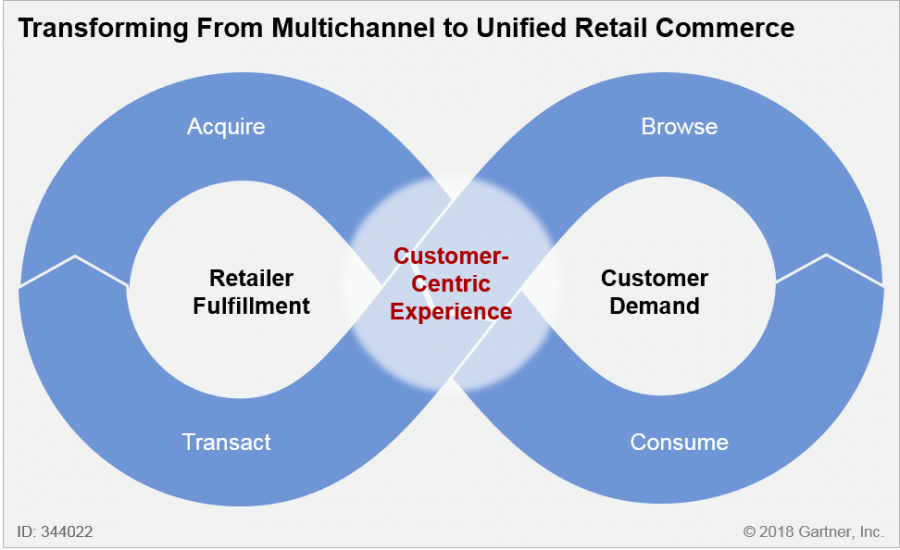March 21, 2023
Varejistas bem-sucedidos são resilientes, capazes de responder às mudanças do mercado com agilidade e confiança. Nos últimos anos, o papel da tecnologia tem se mostrado o maior diferencial, permitindo que varejistas se adaptem facilmente ao inesperado, enquanto empresas menos preparadas desaparecem gradualmente.
No entanto, novas tecnologias e modelos de negócios trazem também novos métodos para medir os resultados de desempenho e negócios.
Em um recente relatório do Gartner, analistas exploram essa transformação. A pesquisa destaca o papel dos CIOs estratégicos e outros líderes na criação de novos KPIs digitais, que medem e quantificam o progresso, orientam decisões importantes e garantem o sucesso da empresa.
>> Agende uma demonstração personalizada com nossa equipe de especialistas e veja como o iPaaS da Digibee trará eficiência ao seu negócio.
Comércio varejista unificado
Os especialistas do Gartner abordam o conceito de comércio varejista unificado (URC1), uma estratégia de negócios moderna que está transformando o setor tanto para varejistas quanto para consumidores.
Diferente do varejo multicanal, o URC oferece uma experiência centrada no cliente, baseada na forma como o consumidor interage com o processo de compra, sem limitações de canal. Para alcançar esse resultado, varejistas de todos os tipos precisam investir em uma transformação digital que apoie quatro processos principais do cliente:
- Explorar e encontrar o que é necessário: descobrir novos produtos e serviços acessíveis em lojas físicas, canais online, dispositivos móveis, redes sociais, dispositivos habilitados para IoT, inteligência artificial, realidade aumentada e outras tecnologias para uma experiência de compra imersiva.
- Realizar transações : navegar entre canais para adquirir produtos e serviços sem inconvenientes ou atrasos, utilizando sistemas de POS interconectados e aplicativos móveis.
- Adquirir bens e serviços: optar por métodos como compras físicas, “clique e retire”, entrega em casa, reabastecimento automatizado e outros modelos de atendimento flexíveis.
- Consumir: aproveitar informações e serviços aprimorados, dispositivos conectados, reabastecimento automático e interações por comandos de voz.

O URC funciona porque leva em conta como os consumidores utilizam a tecnologia no dia a dia e, em seguida, implementa sua própria tecnologia para se alinhar a esse modelo, proporcionando uma experiência mais simples, melhor, fácil e segura.
Novos KPIs de varejo para um novo modelo de negócios
Os varejistas vêm priorizando a centralidade no cliente há anos. No entanto, o modelo URC reforça ainda mais o papel da tecnologia na entrega desses resultados, aproveitando inovações e soluções de ponta para oferecer a melhor experiência ao cliente.
Como em qualquer investimento, os CIOs de varejo e outros líderes precisam quantificar como essas novas tecnologias estão contribuindo para os objetivos do URC e para as metas de negócios.
A metodologia tradicional de KPIs no varejo, por si só, já não é suficiente, pois depende de indicadores retrospectivos que medem resultados. Os KPIs do URC devem incorporar também indicadores preditivos, que monitoram e gerenciam o desempenho de forma proativa e em tempo real, alertando o negócio a tomar medidas antes que ocorram perdas significativas.
Os varejistas devem criar KPIs digitais que reflitam o impacto do modelo URC no desempenho geral do negócio. Isso exige a conexão entre métricas impulsionadas por resultados tecnológicos (TODM) e métricas impulsionadas por resultados de negócios (BODM).
Por exemplo, para identificar novos crescimentos de receita e modelos de negócios, os KPIs digitais devem medir a receita de plataformas, a receita conectada e a receita oriunda de novos setores.
Três pilares essenciais do URC
O relatório do Gartner identificou três pilares principais da estratégia de URC que impulsionam a lucratividade:
1. Front-end e back-end unificados
O URC depende completamente de uma visão unificada da experiência no varejo, tanto para o cliente quanto para o negócio. A integração empresarial desempenha um papel essencial nesse resultado, conectando componentes independentes para oferecer uma visão consolidada da operação, do front-end ao back-end.
Esse ambiente sincronizado aumenta a visibilidade, garantindo uma execução operacional consistente e robusta para uma experiência otimizada do cliente.
Um bom exemplo é a Payless, uma rede internacional de varejo self-service de calçados , com quase 4,500 lojas em 30 países. A varejista implementou uma tecnologia de integração empresarial como serviço (iPaaS) para lançar e integrar uma nova plataforma de e-commerce em sua infraestrutura existente.
A nova solução simplifica as interações com os clientes, consolidando os dados gerados por sistemas de varejo em múltiplos canais — mesmo durante picos de vendas, como na Black Friday e em outros dias de alta demanda.
2. Guiado pela experiência
O URC promove um ambiente digital onde é possível acompanhar as experiências de clientes e colaboradores, assim como o impacto das novas tecnologias digitais no negócio. Com ferramentas inovadoras e dados adicionais de varejo, os colaboradores da linha de frente conseguem executar ações com precisão, oferecendo jornadas personalizadas que aumentam a conversão e a satisfação dos clientes.
Com uma plataforma iPaaS empresarial, os varejistas conectam facilmente sistemas díspares para que dados de várias fontes sejam consolidados e analisados. Por exemplo, planejamento de força de trabalho, gestão de clientes e dados de varejo de outras soluções podem prever horários de pico e baixa movimentação, otimizando o atendimento ao cliente e a experiência dos colaboradores.
KPIs digitais de varejo neste caso incluem a taxa de precisão de escalas geradas automaticamente e o número de colaboradores que utilizam ferramentas móveis para trocar turnos ou fazer lances em escalas. Os insights gerados ajudam a entender as taxas de rotatividade e retenção de funcionários.
3. Composable
Uma estratégia de URC verdadeiramente unificada só é possível com uma estratégia composable de negócios e tecnologia , que conecta aplicativos, canais e pontos de contato em tempo real. Além de apoiar a transformação digital, essa abordagem modular e orientada por APIs simplifica como os sistemas de dados de varejo coletam e analisam informações.
O relatório do Gartner analisa os substitutos de produtos no Walmart como um exemplo de arquitetura modular, onde a rede de supermercados implementou recursos de inteligência artificial em seu ambiente existente. A tecnologia coleta e combina dados de varejo necessários para fazer sugestões inteligentes de substituição, ao mesmo tempo em que acompanha as preferências dos clientes.
Como resultado, o modelo URC é capaz de monitorar em tempo real as taxas de aceitação de substituição de itens, permitindo sugestões melhores, reduzindo impactos negativos e aumentando a fidelidade do cliente.
O KPI digital usado neste exemplo é a porcentagem de clientes que aceitaram as substituições sugeridas.
O papel da integração empresarial no Unified Retail Commerce
Cada varejista atribui diferentes pesos aos KPIs digitais, dependendo da natureza do negócio, dos grupos de clientes atendidos e dos objetivos de curto e longo prazo.
Independentemente dessas diferenças, uma plataforma iPaaS empresarial moderna é essencial para conectar todas as partes móveis, proporcionando uma visão unificada do negócio que apoia e informa o modelo de URC.
A Digibee trabalha com organizações que buscam evoluir seus modelos de negócios. Nossos clientes utilizam o iPaaS low-code da Digibee para integrar sistemas modernos com tecnologias existentes, reduzindo significativamente o tempo e os recursos necessários para acelerar a inovação.
A tecnologia iPaaS da Digibee viabiliza uma estratégia de dados resiliente e ágil, que cresce facilmente com sua organização, independentemente do porte ou da escala. Ajudamos nossos clientes a evoluírem seus negócios, utilizando nosso iPaaS de low-code para integrar sistemas modernos a tecnologias existentes, otimizando o fluxo de dados em toda a operação e oferecendo uma visão única do negócio.
Se você estiver interessado em saber como o Digibee pode ajudar sua organização de varejo, teremos prazer em mostrar a você. Agende uma demonstração com nosso time de especialistas para saber mais.
(1) Gartner, Use Digital Business KPIs to Assess and Improve Unified Retail Commerce Performance, 1º de dezembro de 2022, Hanna Karki, Kelsie Marian
GARTNER é uma marca registrada do Gartner, Inc. e / ou suas afiliadas nos Estados Unidos e internacionalmente são usadas aqui com permissão. Todos os direitos reservados.








